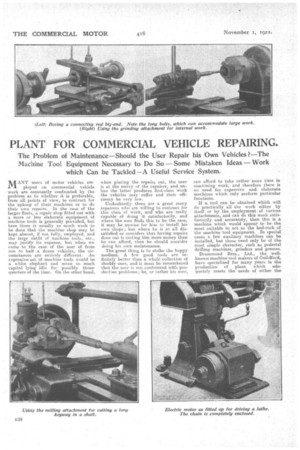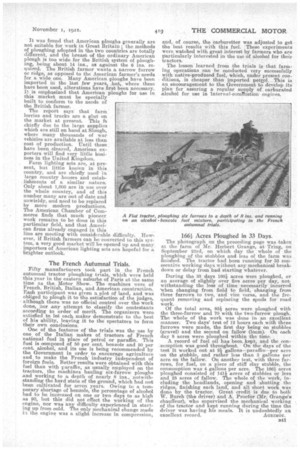PLANT FOR COMMERCIAL VEHICLE REPAIRING.
Page 28

Page 29

If you've noticed an error in this article please click here to report it so we can fix it.
The Problem of Maintenance—Should the User Repair his .Own Vehicles ?—The Machine Tool Equipment Necessary to Do So Some Mistaken Ideas —Work which Can be Tackled --A Useful Service System.
MANY users of motor vehicles employed on commercial vehicle work are constantly confronted by the problem as to whether it is preferable, from all points of view, to contract for the upkeep of their machines or to do their own repairs. In the case of the larger fleets, a repair shop fitted out with a more or less elaborate equipment of machine tools is generally provided, but here there is usually so much work to be done that the machine shop may be kept almost, if not fully, employed, and the large outfit of machine tools, etc., may justify its expense, but when we come to the case of the user of from one to half a dozen vehicles, the circumstances are entirely different. An expensive set of machine tools would be a white elephant and mean 80 much capital lying idle for possibly threequarters of the time. On the other hand,
when placing the repairs out, the user is at the mercy of the repairer, and unless the latter produces first-class work the vehicles may suffer and their efficiency be very low.
Undoubtedly there are a great many repairers who are willing to contract for this class of work, and who are really capable of doing it satisfactorily, and where the user finds this to be the case, it may be unwise for him to install his own shops; but where he is at all dissatisfied or considers that having repairs done out is costing him more money than he can afford, then he should consider doing his own maintenance.
The great thing is to strike the happy medium. A few good tools are infinitely better than a whole collection of shoddy ones, and itmust be remembered that the user is not confronted with production problems; he, or rather his men, can afford to take rather more time in machining work, and therefore there is no need for expensive and elaborate machines which only perform particular functions.
If a tool can be obtained which will do practically all the work either by itself or by the employment of various attachments, and can do this work satisfactorily and accurately, then this is a machine which weuld appear to be the most suitable to act as the bed-rock of the machine tool equipment. In special cases a few auxiliary machines can be installed, but these need only be of the most simple character, such as pedestal drilling machines, grinders and presses.
Drummond Bros., Ltd., the wellknown machine tool makers of Guildford, have specialized for many years in the production of plant which adequately meets the needs of either the
It was found that American ploughs generally are not suitable for work in Great Britain the methods of ploughing adopted in the two countries are totally different, and the breast of the ordinary American plough is too wide for the British system of ploughing, being about 14 ins., as against the 6 ins. required. The British farmer wants a narrow furrow or ridge, as opposed to the American farmer's needs for a wide one. Many American ploughs have been imported in the last few years, but, where these have been used, alterations have first been necessary. It is emphasized that American ploughs for use in this market must be specially built to conform to the needs of the British fanner.
The 'report says that farm lorries and trucks are a glut on the market at present. This fs chiefly due to the large supplies which are still on hand at Slough, where many thousands of war vehicles are available at less than cost of production. Until these have been cleared, American exporters will find very litfle business in the United Kingdom. Farm lighting sets are, at present, but little known in this country, and are chiefly used in large country houses and establishments of a similar nature. Only about 1,000 are in use over the whole country, and of this number many are out of date and unwieldy, and need to be replaced by more modern productions. The American Chamber' of Commerce finds that much pioneer work remains to be done in this particular field, and that American firma already engaged in this lino are meeting with considerable difficulty. However, if British farmers can be converted to this system, a very good market will be opened up and many importers of American lighting sets are hopeful for a brjghter outlook.
The French Autumnal Trials.
Fifty manufacturers took part in the French autumnal tractor ploughing trials which were held this year in the eastern suburbs of Paris at the same time as the. Motor Show. The -machines were of French, British, Italian; and American construction. Each participant was given a plot of land, and was obliged to _plough it to the satisfaction of the judges, although there was no official control over the work done nor any attempt to classify the contestants according to order of merit. The organizers were satisfied to let each, maker demonstrate to the best of his ability, leaving it to the spectators to form their own conclusions.
One of the features of the trials was the use by one of the Italian makes of tractors of French national fuel in place of petrol or paraffin. This fuel is composed of 50 per cent. benzole and 50 per cent, alcohol, and its use is being recommended by the Government in order to encourage agriculture and to make the French industry 'independent of foreign fuels. Better results were obtained with this fuel than with paraffin, as usually. employed on the tractors, the machines hauling stx-furrow ploughs and working to a depth of nearly 8 ins., notwithstanding the hard state of the ground, which had not been cultivated for seven years. Owing to a temporary shortage of benzole, the percentage of alcohol had to be increased on one or two days to as high as 90, but this did not effect the working of the engine, nor was any difficulty experienced in starting up from cold. The only mechanical change made ia the engine was a slight increase in compression,
and, of course, the carburetter was adjusted to get the best results with this fuel. 'These experiments were watched with great interest by farmers who are particularly interested in the use of alcohol for their tractors.
The lesson learned from the trials is that farming operations can be conducted very successfully with native-produced fuel, which, under present conditions, is .cheaper than imported petrol. This is an encouragement to the Government to develoP its plan for assuring a regular supply of carburated alcohol for use in Internal-comrustion engines.
1661 Acres Ploughed in 33 Days.
The photograph on the preceding page was taken at the farm of Mr. Herbert Grange, at Tring, on September 23rd, on which day the whole of the ploughing of the stubbles and leas of the farm was finished. The tractor had been running for 33 consecutive working days without any mechanical breakdown or delay from bad starting whatever.
During the 33 days 166i acres were ploughed, or an average of slightly over five acres per day, not withstanding the loss of time necessarily incurred When changing from field to field, changing from three furrows to two, and vice versa, and the frequent removing and replacing the spuds for road work. Of the total area 95i acres were ploughed with the three-furrow and 70 with the two-furrow plough. The whole of the work was done in an excellent manner. Two days' test of 12 hours each with three furrows were made, the first day being on stubbles (gravel) and the second on fallow (loam). On e.ach day 8 acres were ploughed within the time. A record of fuel oil has been, kept, and the con
-sumption was good throughout. On the days of the test it worked out at 2i gallons—paraffin—per acre on the stubble, and rather less than 3 gallons per acre on the fallow. On another test, with three furrows, for fuel, on a piece of stiff clay stubble, the consumption was 4 gallons per acre. The 160 acres ploughed consisted of 141i acres of stubbles or leas and 25 acres of fallow. The whole of the work, including the headlands, opening and -shutting the ridges, finishing each land, and all short work was done by the tractor. Great credit is due to both W. Burch (the driver) and A. Procter (Mr: Grange's chauffeur), who supervised the mechanical working of the tractor and kept running during the time the driver was having his meals. It is undoubtedly an
excellent record. AGRIMOT.
































